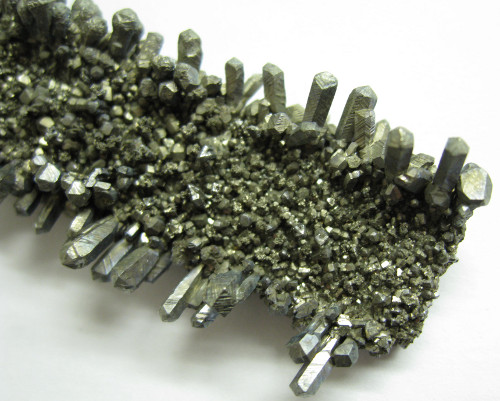Niobium
Niobium (Cb), also called columbium, is a rare metal, which is steel gray, resistant to acids, and has a high melting point. Elemental niobium is a soft, ductile, malleable metal with a moderately high specific gravity (8.57). It is used mainly as an additive in stainless steel and imparts creep resistance and fatigue strength in light-weight high-temperature alloys. Niobium is critical because of its defense-related uses in aerospace, energy, and transportation industries.

Three areas of significant niobium mineralization occur in Arkansas: Magnet Cove in Hot Spring County, Potash Sulphur Springs in Garland County, and the bauxite deposits in Saline and Pulaski Counties. The first two locations are characterized by alkaline igneous intrusions and mineralized zones of contact metamorphism and the third by the concentration of titanium minerals in bauxite. In the Magnet Cove area, there are substantial deposits of titanium minerals, rutile and brookite (TiO2), and perovskite (CaTiO3). Rutile and brookite crystals contain an average of 2 percent and a maximum of 5 percent niobium. Perovskite may contain up to 9 percent niobium by analysis because niobium substitutes for titanium in the mineral's structure. The U.S. Bureau of Mines calculated that 12 million pounds of niobium are present in the rutile-brookite deposits at Magnet Cove. The niobium of the Potash Sulphur Springs area is present as an essential element of the mineral pyrochlore ((Ca,Na)2Nb2O6(OH,F)). Soil samples analyzed from this area contained up to 0.9 percent niobium. Another possible source of niobium in Arkansas is in the processed bauxite waste material. Arkansas bauxite contains niobium from 0.02 to 0.1 percent and averages 0.05 percent. In 1954, the U. S. Bureau of Mines calculated that bauxite deposits and plant waste fines contained up to 150 million pounds of niobium metal.
Although niobium-bearing minerals have long been known to exist in the state, there has been no commercial recovery. If any sites enriched in titanium-bearing minerals become economic, niobium may be recovered as a by-product.
References
Image courtesy of Dnn87 from https://commons.wikimedia.org/wiki/File:Nb-Niobium.JPG